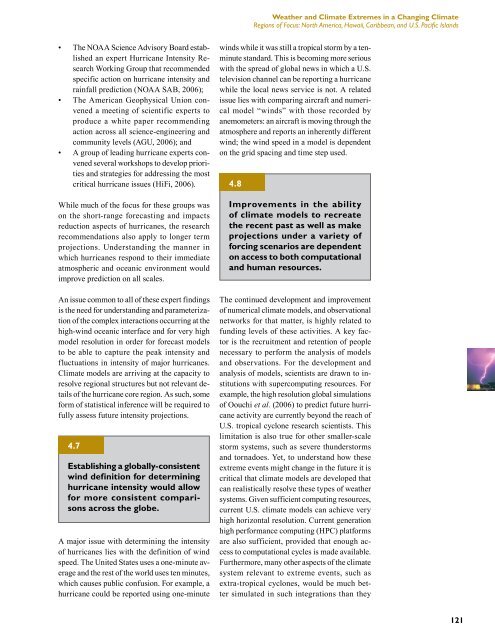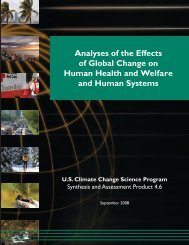Weather and Climate Extremes in a Changing Climate. Regions of ...
Weather and Climate Extremes in a Changing Climate. Regions of ...
Weather and Climate Extremes in a Changing Climate. Regions of ...
You also want an ePaper? Increase the reach of your titles
YUMPU automatically turns print PDFs into web optimized ePapers that Google loves.
•<br />
•<br />
•<br />
The NOAA Science Advisory Board established<br />
an expert Hurricane Intensity Research<br />
Work<strong>in</strong>g Group that recommended<br />
specific action on hurricane <strong>in</strong>tensity <strong>and</strong><br />
ra<strong>in</strong>fall prediction (NOAA SAB, 2006);<br />
The American Geophysical Union convened<br />
a meet<strong>in</strong>g <strong>of</strong> scientific experts to<br />
produce a white paper recommend<strong>in</strong>g<br />
action across all science-eng<strong>in</strong>eer<strong>in</strong>g <strong>and</strong><br />
community levels (AGU, 2006); <strong>and</strong><br />
A group <strong>of</strong> lead<strong>in</strong>g hurricane experts convened<br />
several workshops to develop priorities<br />
<strong>and</strong> strategies for address<strong>in</strong>g the most<br />
critical hurricane issues (HiFi, 2006).<br />
While much <strong>of</strong> the focus for these groups was<br />
on the short-range forecast<strong>in</strong>g <strong>and</strong> impacts<br />
reduction aspects <strong>of</strong> hurricanes, the research<br />
recommendations also apply to longer term<br />
projections. Underst<strong>and</strong><strong>in</strong>g the manner <strong>in</strong><br />
which hurricanes respond to their immediate<br />
atmospheric <strong>and</strong> oceanic environment would<br />
improve prediction on all scales.<br />
An issue common to all <strong>of</strong> these expert f<strong>in</strong>d<strong>in</strong>gs<br />
is the need for underst<strong>and</strong><strong>in</strong>g <strong>and</strong> parameterization<br />
<strong>of</strong> the complex <strong>in</strong>teractions occurr<strong>in</strong>g at the<br />
high-w<strong>in</strong>d oceanic <strong>in</strong>terface <strong>and</strong> for very high<br />
model resolution <strong>in</strong> order for forecast models<br />
to be able to capture the peak <strong>in</strong>tensity <strong>and</strong><br />
fluctuations <strong>in</strong> <strong>in</strong>tensity <strong>of</strong> major hurricanes.<br />
<strong>Climate</strong> models are arriv<strong>in</strong>g at the capacity to<br />
resolve regional structures but not relevant details<br />
<strong>of</strong> the hurricane core region. As such, some<br />
form <strong>of</strong> statistical <strong>in</strong>ference will be required to<br />
fully assess future <strong>in</strong>tensity projections.<br />
4.7<br />
Establish<strong>in</strong>g a globally-consistent<br />
w<strong>in</strong>d def<strong>in</strong>ition for determ<strong>in</strong><strong>in</strong>g<br />
hurricane <strong>in</strong>tensity would allow<br />
for more consistent comparisons<br />
across the globe.<br />
A major issue with determ<strong>in</strong><strong>in</strong>g the <strong>in</strong>tensity<br />
<strong>of</strong> hurricanes lies with the def<strong>in</strong>ition <strong>of</strong> w<strong>in</strong>d<br />
speed. The United States uses a one-m<strong>in</strong>ute average<br />
<strong>and</strong> the rest <strong>of</strong> the world uses ten m<strong>in</strong>utes,<br />
which causes public confusion. For example, a<br />
hurricane could be reported us<strong>in</strong>g one-m<strong>in</strong>ute<br />
<strong>Weather</strong> <strong>and</strong> <strong>Climate</strong> <strong>Extremes</strong> <strong>in</strong> a Chang<strong>in</strong>g <strong>Climate</strong><br />
<strong>Regions</strong> <strong>of</strong> Focus: North America, Hawaii, Caribbean, <strong>and</strong> U.S. Pacific Isl<strong>and</strong>s<br />
w<strong>in</strong>ds while it was still a tropical storm by a tenm<strong>in</strong>ute<br />
st<strong>and</strong>ard. This is becom<strong>in</strong>g more serious<br />
with the spread <strong>of</strong> global news <strong>in</strong> which a U.S.<br />
television channel can be report<strong>in</strong>g a hurricane<br />
while the local news service is not. A related<br />
issue lies with compar<strong>in</strong>g aircraft <strong>and</strong> numerical<br />
model “w<strong>in</strong>ds” with those recorded by<br />
anemometers: an aircraft is mov<strong>in</strong>g through the<br />
atmosphere <strong>and</strong> reports an <strong>in</strong>herently different<br />
w<strong>in</strong>d; the w<strong>in</strong>d speed <strong>in</strong> a model is dependent<br />
on the grid spac<strong>in</strong>g <strong>and</strong> time step used.<br />
4.8<br />
Improvements <strong>in</strong> the ability<br />
<strong>of</strong> climate models to recreate<br />
the recent past as well as make<br />
projections under a variety <strong>of</strong><br />
forc<strong>in</strong>g scenarios are dependent<br />
on access to both computational<br />
<strong>and</strong> human resources.<br />
The cont<strong>in</strong>ued development <strong>and</strong> improvement<br />
<strong>of</strong> numerical climate models, <strong>and</strong> observational<br />
networks for that matter, is highly related to<br />
fund<strong>in</strong>g levels <strong>of</strong> these activities. A key factor<br />
is the recruitment <strong>and</strong> retention <strong>of</strong> people<br />
necessary to perform the analysis <strong>of</strong> models<br />
<strong>and</strong> observations. For the development <strong>and</strong><br />
analysis <strong>of</strong> models, scientists are drawn to <strong>in</strong>stitutions<br />
with supercomput<strong>in</strong>g resources. For<br />
example, the high resolution global simulations<br />
<strong>of</strong> Oouchi et al. (2006) to predict future hurricane<br />
activity are currently beyond the reach <strong>of</strong><br />
U.S. tropical cyclone research scientists. This<br />
limitation is also true for other smaller-scale<br />
storm systems, such as severe thunderstorms<br />
<strong>and</strong> tornadoes. Yet, to underst<strong>and</strong> how these<br />
extreme events might change <strong>in</strong> the future it is<br />
critical that climate models are developed that<br />
can realistically resolve these types <strong>of</strong> weather<br />
systems. Given sufficient comput<strong>in</strong>g resources,<br />
current U.S. climate models can achieve very<br />
high horizontal resolution. Current generation<br />
high performance comput<strong>in</strong>g (HPC) platforms<br />
are also sufficient, provided that enough access<br />
to computational cycles is made available.<br />
Furthermore, many other aspects <strong>of</strong> the climate<br />
system relevant to extreme events, such as<br />
extra-tropical cyclones, would be much better<br />
simulated <strong>in</strong> such <strong>in</strong>tegrations than they<br />
121




